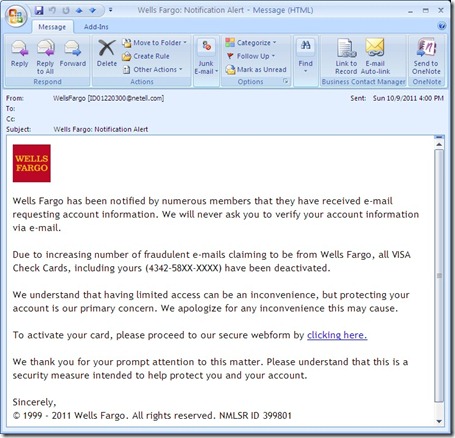Folks, please, please, please be very careful of what you click on and what financial information you provide. Especially in response to an ‘alerting’ email!
There are a great number of ‘phishing’ attacks occurring again and they are getting even more sophisticated. Many almost look and sound legitimate. I have written previously on some of this here.
But as a reminder, if you get an email or text telling you you must login to a financial (or any other for that matter) site via a link in an email DO NOT CLICK ON ANY LINK AND MOST IMPORTANTLY DON’T ENTER ANY INFORMATION IF YOU DO!!
If you must visit a bank, credit card or online vendors site for ‘verification’ or what ever do so through the ‘Front Door’. By that I mean open a brand new Web Browser window and log in to ‘their site’ and proceed from there. i.e. https://wellsfargo.com etc.
If you click on many of these links a few things are likely to happen. 1st you will probably be silently infected by a Trojan/backdoor application and 2nd you will probably be brought to a ‘bogus’ site that looks very much like the legitimate site. You will be prompted to enter in financial and/or information such as account/card numbers passwords and other verification. The MOMENT you do you can be assured that your account will be compromised! Sometimes in as little as a few minutes your account can be emptied!
Here is an example of one of the hundreds of emails that have been hitting my email server this weekend. You can see that it almost looks legitimate; the wording is sufficiently scary and authoritative and there is a ‘real logo’. But the link in the email is to a phishing site. AND the email address on the ‘from’ is not correct.
This looks very ‘scary’ and it is – but for the reason that you WILL be screwed, not that you are yet.
Please use some caution in the digital world. You would not give a perfect stranger your bank card and pin but some will do just that in cyberspace.
Be safe folks!
